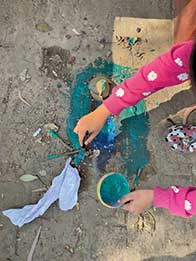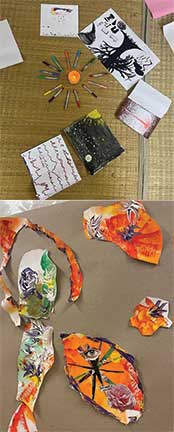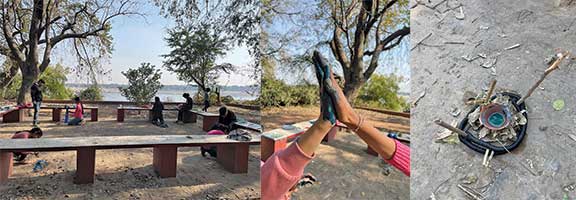Ayushi Agarwal
Where do I, a lifelong learner with a decade of facilitating arts integrated sessions, stand when it comes to learning with the arts?

I have thoughts and I have questions.
What ignites me is what I have experienced; the beauty, joy and power of the arts!
I intend to lay it all bare to witness and be witnessed in my journey that is unfolding and being shaped by the people I have had the honour to learn from while facilitating and learning.
I have always had a deep connection with the arts. I have been a singer, a Bharatanatyam dancer and when I was young was told that I was good at it. I enjoyed painting but was ‘aware’ that ‘I’m not a good visual artist’. This belief that I wasn’t good enough as a visual artist was my cue to focus on what I was ‘good’ at.

Today, when I look back, I have questions –
• Who decided whether I was ‘good’ or ‘not good enough’?
• Why did I not give importance to what brought me joy?
• Why did I compare myself with others?
• Why was I running behind trophies and accolades?
At the same time, I also realize –
• I hardly explored different arts modalities.
• I did what I was told.
• I didn’t hone my unique artistic voice.
• I stopped feeling like a creative being.
While I value and appreciate disciplined practice of an art form, I wish for more lightness, exploration, and openness within the practice of these art forms; for space to explore more and to integrate. I also wonder why arts and academics have such distinct demarcations! Why do they function in isolation!
College days
My experience with my creative self reignited when, as a college student, I started facilitating English classes on Sundays, with an NGO, Make A Difference (MAD).
Here, I met young people who opened up the possibility of integrating creative ways of facilitating sessions so that the sessions could be more effective for the students. This opened up a whole new world for me. Preparing for these sessions had me excited. These sessions helped me build relations with the students. I felt motivated, determined, and passionate.
What changed? How did it all happen?

The crux lay in the environment where there was freedom along with guidance and supportive structure –
• I learnt how to create materials for sessions, track progress of students, and reflect on my work.
• We had agency and breathing space.
• We were invited to bring in our own energy to the collective energy.
• Sharing of good practices and space to discuss areas of improvement.
• Prioritizing the students we engaged with and making note of their individual capacities.
It was working together, and not in isolation, which made it all possible. In the process I also figured out my passion for working with children, of engaging with them. I took up a course in storytelling. It is a form that is engaging, embodied, participative, and simple to understand. Students can connect with it easily. One can encompass multiple arts and touch upon myriad subjects through storytelling.

Back to school
After that, I got an opportunity to work full-time at a school run by the Krishnamurti Foundation India (KFI). Here, through storytelling, I could also invite students to become storytellers. Some enjoyed the storytelling sessions so much that they ended up reading the stories as well. While some enjoyed creative writing, decorating their sheets, and illustrating their articles. The students had different learning aptitudes and abilities. At the same time, they also had individual voices.
What was different here?
• A large open space with ample trees.
• A grounding philosophy.
• Small group-size that made is possible to listen to all students.
• Activities like creative writing day where all teachers and students got together and wrote.
There were challenges as well. It wasn’t easy to keep the students motivated each day and meet their individual learning needs.
During this time, I undertook an applied theatre course in the Theatre of the Oppressed. I felt enthused and empowered after experiencing Forum Plays, in which the audience gets to participate by replacing the oppressed character. The audience member then has to try ways to reach a more empowered space from an oppressed space. I took my learning to the students and it appeared to work. The elder students came up with a Forum Play on gender-based oppression faced by girls. A five-minute skit opened up action-based discussion that went longer than two hours and students wanted more time. Some of the students who resonated with the struggles of the oppressed female character, came up to take the role of the character and tried ways in which the character could feel more empowered. Students shared that they had never had a space in class or dorm where everyone in a group genuinely wanted to hear each other share their stories. They also created their own plays on topics that they were passionate about.
Some aspects stood out –
• The sessions worked beautifully when they were voluntary.
• Students wanted their voices to be heard.
• The initial hesitation to do body-based activities melted away with setting the intention, tone, and agreements of the theatre sessions. The embodied activities gave the students a feel of release and openness.
• The students respected themselves. They also invited others to co-create a safe and brave space.
• The students felt they owned the space and that they had agency there. My letting go of control helped.
• Transparency about the process and open sharing with the participants helped my growth as a facilitator.
Moving ahead, I began to seek an art form that could integrate all my varied interests and I chanced upon intermodal expressive arts. Here exploration though different art modalities, brings forth insights, expression of what needs to be expressed. It is a transformative and therapeutic experience. The healing power of the arts has been felt by many. I enjoyed holding Explore, Express and Create sessions at the school to connect with the creativity, unique artistic expression, and space of exploration of the participants.
These sessions enabled space for me to flow in a wide frame. They were some of the most freeing sessions I had till then had the experience of facilitating. This openness provided space for spontaneity. One could be present to what’s emerging in their artistic exploration. The focus was on experiencing and being present to the artistic process.
In a session we intentionally moved from one art modality, like visual art to the next like movement, to explore what emerged in the first art form in a deeper way through the second. I observed –
• Students and teachers participated as equals and deeply resonated with what emerged through their artistic exploration.
• They shared that they felt therapeutic and enjoyed exploring the unknown.
• Many of them added that they could let go of their inhibitions. Inhibitions of not ‘being a creative person’, ‘an artist’, ‘a singer’, ‘a dancer’.
Students shared that they connected with being dancers as that is what they knew. But when they were given the space to explore movement and not told what to do, they felt lost. In the second part, when they were asked to explore with paints, they felt much more freer picking up a paintbrush for the very first time.

A full circle
This brings me back a full circle. As I shared at the beginning of this article, I did what I was told as a young person. I would have loved to know that I can give myself permission to explore and try new things with my art form and other art forms.
For me the magic of the arts is that –
• Arts are freeing, not restrictive.
• Arts equalise, not divide.
I invite us all to –
• Give ourselves permission to explore with the arts and in life.
• Find our own creative voice.
• Believe in the gifts we bring.
• Know that we are not alone.
So I ask us, how often do we flow with the arts?
Arts are alive! They provide a space to experiment, explore, question, discover, observe, dialogue, accept, let go, take decisions, be spontaneous and I can go on.
Life offers all these possibilities too.
Our academic subjects offer them too.
Let’s be curious and see what emerges when we take the arts to life and learning.
The author is a freelance intermodal expressive arts practitioner, storyteller and applied theatre facilitator. She curates and facilitates nature and arts-based sessions to connect with creativity, self, others, nature and to unwind with the arts. She believes in the creative capacities of every individual and has been spreading joy with the arts through her sessions. She enjoys connecting and can be reached at beingexa@gmail.com.
Related Articles
